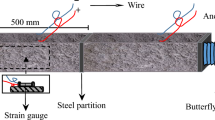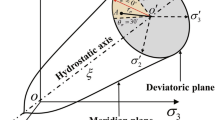Abstract
The critical state concept has been widely used in soil mechanics. The purpose of this study is to apply this concept in the framework of multi-mechanism elastoplasticity. The developed model has two yield surfaces: one for shear sliding and one for compression. In this model, the location of the critical state line is explicitly considered and related to the actual material density to control the peak strength and the phase transformation characteristics. The stress reversal technique is incorporated into the model for describing clay behavior under complex loading including changes of stress direction. The determination of the model parameters is discussed; it requires only one drained or undrained triaxial test up to failure with an initial isotropic consolidation stage. The model is used to simulate drained and undrained tests under monotonic loading with different over-consolidation ratios on various remolded and natural clays, including true triaxial tests with different Lode’s angles. Drained and undrained tests under cyclic loadings are also simulated by using the set of parameters determined from monotonic tests. The comparison between experimental results and numerical simulations demonstrate a good predictive ability of this new simple model.















Similar content being viewed by others
References
Balendran B, Nemat-Nasser S (1993) Double sliding model for cyclic deformation of granular materials including dilatancy effects. J Mech Phys Solids 41(3):573–612
Been K, Jefferies MG (1985) A state parameter for sands. Geotechnique 35(2):99–112
Biarez J, Hicher PY (1994) Elementary mechanics of soil behaviour, Balkema
Bryson LS, Salehian A (2011) Performance of constitutive models in predicting behavior of remolded clay. Acta Geotech 6:143–154
Calladine CR (1971) Microstructural view of the mechanical properties of saturated clay. Geotechnique 21(4):391–415
Chang CS, Yin Z-Y (2010) Modeling stress-dilatancy for sand under compression and extension loading conditions. ASCE J Eng Mech 136(6):777–786
Chang CS, Yin Z-Y (2010) Micromechanical modelling for inherent anisotropy in granular materials. ASCE J Eng Mech 136(7):830–839
Chowdhury EQ, Nakai T (1998) Consequence of the tij-concept and a new modelling approach. Comput Geotech 23(4):131–164
Dafalias YF, Manzari MT, Papadimitriou AG (2006) SANICLAY: simple anisotropic clay plasticity model. Int J Numer Anal Methods Geomech 30(12):1231–1257
Gajo A, Muir Wood D (1999) Severn–Trent sand: a kinematic-hardening constitutive model: the q–p formulation. Geotechnique 49(5):595–614
Gens A (1982) Stress–strain and strength of a low plasticity clay. Ph.D. Thesis at Imperial College, London University
Hardin BO (1978) The nature of stress–strain behaviour of soils. In: Proceedings of the earthquake engineering and soil dynamics, vol 1, Pasadena, USA, pp 3–90
Hirayama H (1987) Interpretation of the cam-clay model as a simplified double-yield-surface model. Soils Found 27(3):105–111
Hsieh HS, Kavazanjian JE, Borja RI (1990) Double-yield-surface Cam-clay plasticity model. I: theory. J Geotech Eng 116(9):1381–1401
Huang WX, Wu W, Sun DA, Scott S (2006) A simple hypoplastic model for normally consolidated clay. Acta Geotech 1:15–27
Hujeux JC (1985) Une loi de comportement pour le chargement cyclique des sols. In: Davidovici V (ed) Génie Parasismique. Presses ENPC, France, pp 278–302
Jefferies MG (1993) NorSand: a simple critical state model for sand. Geotechnique 43(1):91–103
Ladd CC, Varallyay J (1965) The influence of the stress system on the behaviour of saturated clays during undrained shear. Research Rep. No. R65-11, Department of Civil Engineering, MIT, Cambridge, MA
Lade PV (2007) Modeling failure in cross-anisotropic frictional materials. Int J Solids Struct 44(16):5146–5162
Li T, Meissner H (2002) Two-surface plasticity model for cyclic undrained behavior of clays. ASCE J Geotech Geoenviron Eng 128(7):613–626
Ling HI, Yue D, Kaliakin VN (2002) Anisotropic elastoplastic bounding surface model for cohesive soils. ASCE J Eng Mech 128(7):748–758
Mašin D (2005) A hypoplastic constitutive model for clays. Int J Numer Anal Methods Geomech 29(4):311–336
Nakai T, Hinokio M (2004) A simple elastoplastic model for normally and overconsolidated soils with unified material parameters. Soils Found 44(2):53–70
Ohmaki S (1979) A mechanical model for the stress–strain behaviour of normally consolidated cohesive soil. Soils Found 19(3):29–44
Pestana JM, Whittle AJ, Gens A (2002) Evaluation of a constitutive model for clays and sands: Part II—Clay behaviour. Int J Numer Anal Methods Geomech 26(11):1123–1146
Roscoe KH, Burland JB (1968) On the generalized stress–strain behavior of ‘wet’ clay. Engineering Plasticity. Cambridge University Press, Cambridge, pp 553–609
Schofield AN, Wroth CP (1968) Critical state soil mechanics. Mcgraw Hill, Maidenhead
Schweiger H, Wiltafsky C, Scharinger F, Galavi V (2009) A multilaminate framework for modelling induced and inherent anisotropy of soils. Geotechnique 59(2):87–101
Sheng D, Sloan SW, Yu HS (2000) Aspects of finite element implementation of critical state models. Comput Mech 26:185–196
Stallebrass SE, Taylor RN (1997) The development and evaluation of a constitutive model for the prediction of ground movements in overconsolidated clay. Geotechnique 47(2):235–253
Taiebat M, Dafalias YF (2008) SANISAND: simple anisotropic sand plasticity model. Int J Numer Anal Methods Geomech 32(8):915–948
Vermeer PA (1978) A double hardening model for sand. Geotechnique 28(4):414–433
Wheeler SJ, Näätänen A, Karstunen M, Lojander M (2003) An anisotropic elasto-plastic model for soft clays. Can Geotech J 40:403–418
Whittle AJ, Kavvadas MJ (1994) Formulation of MIT-E3 constitutive model for overconsolidated clays. J Geotech Eng 120(1):173–198
Yamakawa Y, Hashiguchi K, Ikeda K (2010) Implicit stress-update algorithm for isotropic Cam-clay model based on the subloading surface concept at finite strains. Int J Plast 26(5):634–658
Yao YP, Hou W, Zhou AN (2009) UH model: three-dimensional unified hardening model for overconsolidated clays. Geotechnique 59(5):451–469
Yin Z-Y, Chang CS (2009) Microstructural modelling of stress-dependent behaviour of clay. Int J Solids Struct 46(6):1373–1388
Yin Z-Y, Chang CS (2013) Stress-dilatancy for sand under loading and unloading conditions. Int J Num Anal Methods Geomech. doi:10.1002/nag.1125
Yin Z-Y, Chang CS, Hicher PY, Karstunen M (2009) Micromechanical analysis of kinematic hardening in natural clay. Int J Plast 25(8):1413–1435
Yin Z-Y, Chang CS, Hicher PY (2010) Micromechanical modelling for effect of inherent anisotropy on cyclic behaviour of sand. Int J Solids Struct 47(14–15):1933–1951
Yu H-S, Khong C, Wang J (2007) A unified plasticity model for cyclic behaviour of clay and sand. Mech Res Commun 34:97–114
Zervoyannis C (1982) Etude synthetique des proprietes mecaniques des argiles et des sables sur chemins oedometrique et triaxial de revolution. Ph.D. thesis, Ecole Centrale de Paris
Acknowledgments
This research was financially supported by the opening project of the State Key Laboratory of Geohazard Prevention and Geoenvironment Protection (Grant No. SKLGP2013K025), the National Natural Science Foundation of China (Grant No. 41240024), the Research Fund for the Doctoral Program of Higher Education of China (Grant No. 20110073120012), and the Shanghai Pujiang Talent Plan (Grant No. 11PJ1405700).
Author information
Authors and Affiliations
Corresponding author
Rights and permissions
About this article
Cite this article
Yin, ZY., Xu, Q. & Hicher, PY. A simple critical-state-based double-yield-surface model for clay behavior under complex loading. Acta Geotech. 8, 509–523 (2013). https://doi.org/10.1007/s11440-013-0206-y
Received:
Accepted:
Published:
Issue Date:
DOI: https://doi.org/10.1007/s11440-013-0206-y




